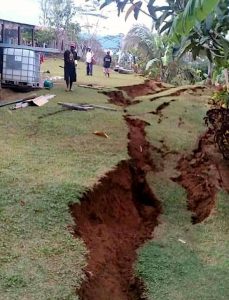
By Sonali Paul and Melanie Burton
MELBOURNE (Reuters) – Up to 14 people were killed in landslides and by collapsed buildings during a powerful earthquake in the remote Papua New Guinea highlands, police and a hospital worker said on Tuesday, with unconfirmed reports of up to 30 dead.
The 7.5 magnitude quake that rocked the region early on Monday also damaged mining and power infrastructure and led ExxonMobil Corp to shut its $19 billion liquefied natural gas (LNG) plant, the country’s biggest export earner.
Two buildings collapsed and along with a landslide killed 12 people in Mendi, the provincial capital of the Southern Highlands, said Julie Sakol, a nurse at Mendi General Hospital, where the bodies were brought to the morgue.
“People are afraid. The shaking is still continuing. There’s nowhere to go but people are just moving around,” she said.
Dozens of aftershocks rattled the area, including a 5.7 quake on Tuesday afternoon, the U.S. Geological Survey reported.
Police in Mendi said 14 people were killed in the initial quake, including three in Poroma, south of Mendi.
“They were killed by landslides destroying families sleeping in their houses,” said Naring Bongi, a police officer in Mendi.
Provincial Administrator William Bando said more than 30 people were believed to have been killed in the rugged region, about 560 km (350 miles) northwest of the capital, Port Moresby, the Papua New Guinea Post-Courier reported.
The PNG disaster management office said it was verifying the reports but it could take days to confirm a death toll.
With a lack of communications preventing a clear assessment of damage, aid agencies had not yet begun relief efforts, said Udaya Regmi, head of the International Red Cross in Papua New Guinea, in Port Moresby.
“The magnitude of the earthquake is quite huge, so there must be an impact … but we cannot say how many people are actually affected and what they need,” Regmi said.
Prime Minister Peter O’Neill said the defense force was on standby to assist “when the extent of damage has been confirmed.”

Locals stand next to a damaged house near a landslide in the town of Tari after an earthquake struck Papua New Guinea’s Southern Highlands in this image taken February 27, 2018 obtained from social media. Francis Ambrose/via REUTERS
“We know that there have been houses lost, roads cut by land slips and disruption to services,” he said in a statement.
ExxonMobil said communications with nearby communities remained down, hampering efforts to assess damage to its facilities that feed the PNG LNG plant.
“Communications continue to be one of the most significant challenges,” the company said in an emailed statement.
Its partner, Oil Search Ltd, said a review of all of its facilities and infrastructure would take at least a week, and an industry source told Reuters that the Exxon plant will likely be shut at least seven days.
Miners Barrick Gold Corp and Ok Tedi Mining also reported damage to infrastructure.
LNG SHUTDOWN
The PNG LNG project is considered one of the world’s best-performing LNG operations, having started exports in 2014 ahead of schedule, despite the challenge of drilling for gas and building a plant and pipeline in the remote jungle of PNG.
The liquefaction plant has also been producing at around 20 percent above its rated capacity of 6.9 million tonnes a year.
ExxonMobil said it shut the two LNG processing units, or trains, at its site on the coast near Port Moresby after earlier shutting its Hides gas conditioning plant and Hides production pads in Hela province in the highlands region.
Gas is processed at Hides and transported along a 700 km (435 miles) line that feeds the PNG LNG plant, whose main customers are in Japan, China and Taiwan.
Traders said the impact on the LNG market would depend on the duration of the shutdown, but noted that spot prices have recently fallen from more than $10 per million British thermal units (mmBtu) as North Asia is coming out of the period of heavy winter gas demand. [LNG/]
“The global LNG market is likely to respond immediately as the buyers need to seek alternative sources,” said Boseok Jin, a research analyst at HIS Markit.
INFRASTRUCTURE DAMAGE
Barrick said some activities at the Porgera gold mine have been suspended to save electricity as the power station that supplies the mine had been damaged.
The mine is co-owned by Barrick and China’s Zijin Mining.
State-owned Ok Tedi said by email that a landslip had blocked a road and damaged pipelines to its copper and gold mine in the Star Mountains, adding that the road would take up to two days to be cleared.
Earthquakes are common in Papua New Guinea, which sits on the Pacific’s “Ring of Fire”, a hotspot for seismic activity due to friction between tectonic plates. Part of PNG’s northern coast was devastated in 1998 by a tsunami, generated by a 7.0 quake, which killed about 2,200 people.
(Reporting by Melanie Burton and Sonali Paul; Additional reporting by Tom Westbrook in SYDNEY, Charlotte Greenfield in WELLINGTON, Jessica Jaganathan and Oleg Vukmanovic in SINGAPORE, and Osamu Tsukimori in TOKYO; Editing by Richard Pullin, Tom Hogue, William Maclean)





